|
|

All titles available through 
oe critical readers in visual cultures
oe is a series of critical readers into contemporary visual cultures; their emergences, contingencies and possibilities.
The series is edited by Katya Sander and Simon Sheikh, artist and theorist. We are committed to theory, but not to discipline, and every reader thus revolves around a specific notion or event, seen and discussed from various vantage points or positions.
Through an analysis of visual cultures – art, film, tv, the net, the street and so on – different regimes of visuality can be located. The circulation, production, reproduction and interpretation of images is seen as crucial to an understanding of contemporary politics, not just of representation, but also of the imaginary. Analysis is therefore not only to be understood as reflective, but also as active or activating. It is proposition(s).
____
#8: Work the Room: A Handbook of Performance Strategies / Ein Handbuch zu Performancestrategien
Edited by Ulrike Müller
All texts in English and German.
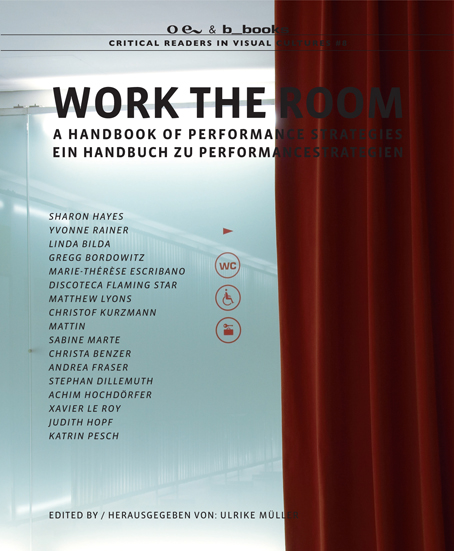
Work the Room criss-crosses the field of contemporary performance art investigating critical actions and the forms they take: How can politics be performed when the public consists of those present and sharing a room? How can the space between performer and audience be activated? What if we are mobilized by our emotions more than by our political convictions?
Work the Room durchquert das Feld gegenwärtiger Performancekunst und untersucht verschiedene Formen kritischen Handelns: Wie kann Politik aufgeführt werden, wenn Öffentlichkeit aus den gemeinsam an einem Ort Anwesenden besteht? Wie kann der Raum zwischen PerformerIn und Publikum aktiviert werden? Was bedeutet es, mehr von unseren Gefühlen mobilisiert zu sein als von unseren politischen Überzeugungen?
With contributions by / Mit Beiträgen von: Christa Benzer, Linda Bilda, Gregg Bordowitz, Stephan Dillemuth, Discoteca Flaming Star, Marie-Thérèse Escribano, Andrea Fraser, Sharon Hayes, Achim Hochdörfer, Judith Hopf, Christof Kurzmann, Xavier Le Roy, Matthew Lyons, Sabine Marte, Mattin, Katrin Pesch, Yvonne Rainer und Britta Scholze.
Edited and with an introduction by / Herausgegeben und mit einem Vorwort von: Ulrike Müller.
Order this book here.
____
#7: Capital (It Fails Us Now)
Edited by Simon Sheikh
English only.

What does it mean to live under certain historical conditions, such as the current hegemony of the capitalist mode of production? What does it mean in terms of economic and social relations, in terms of political space and imagination? How does capitalism affect our nervous systems, subjectivities and desires? These are some of the questions we have tried to pose, if not answer, in Capital (It Fails Us Now).
In these pages a number of essays and projects take their point of departure in these specific models of (re)production and (re)distribution, and look at how production is changing in the Western countries, mainly from industrial production to immaterial labor, and in the East from state capitalism to a deregulated (post)industrialism with a new commodification and codification of the labor force, and thus of all social as well as economical relations. What are “new” economies, and what kinds of technologies of the self are they producing, and indeed, enforcing?
Discussions range from the spectral form of value, (self)precarization, deregulation and the privatization of the welfare state to the development of alternative economies and the establishment of various modes of critique and resistance, cartography and historiography, inclination and inquiry, and the politicization of subject positions.
Edited by Simon Sheikh.
Contributions from: Brian Holmes, Oleg Kireev, Stephan Geene, Isabell Lorey, Katja Diefenbach, Gerald Raunig, Trude Iversen, Fia-Stina Sandlund, Elin Wikström, Natascha Sadr Haghighian, Olafur Gislason, Michael Blum, Jason Simon, Knut Åsdam, Regina Dold, Katia Foquet, Florian Gass, Marietta Kesting, Katya Sander, Ashley Hunt, Oliver Ressler, Copenhagen Free University, Maria Eichhorn, Andrea Creutz, Chto Delat?, Susan Kelly and Stephen Morton.
Order this book here.
____
#6: Here and Elsewhere: Routings, Relationalities and Imaginings between places (forthcoming)
Reader & DVD. Edited by Katya Sander, Simon Sheikh and Hito Steyerl.
Texts & videos by:
An Architektur, François Bucher, Zach Formwalt, Andrea Geyer, Sharon Hayes, Brian Holmes, Janna Holmstedt, Ashley Hunt, Anders Michelsen, Yates McKee, Gerald Raunig, Georg Schöllhammer, Hito Steyerl, Alex Villar, Ulf Wuggenig, among others.
____
#5: In the Place of the Public Sphere?
Edited by Simon Sheikh.
English only.
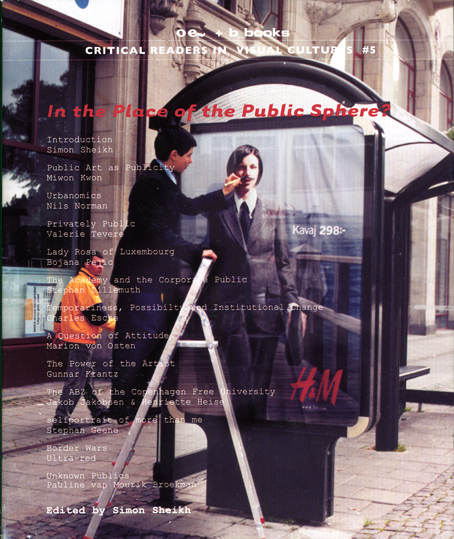
In the Place of the Public Sphere? takes its point of departure in conceptions of practice and spectatorship based on the notion of a fragmented public sphere, and explores the potentials, problematics and politics lying behind the construction (real or imaginary) of particular "public" spheres. How does one perceive and/ or construct specific public spheres and positional and/ or participatory models for spectatorship as opposed to (modernist) generalized ones? Does this entail a reconfiguration of the (bourgeois) notion of the public sphere into a different arena and/ or into a mass of different, overlapping spheres? Or, in other words, what can be put in the place of the public sphere? Private zones, salons, institutions, sub- and/ or counter-publics? And what are the different arenas, possibilities and methods for interaction within and between them? Finally, the question to be raised is how this should relate to artistic production and art's spaces and institutions?
Edited by Simon Sheikh. Texts by Miwon Kwon, Nils Norman, Valerie Tevere, Bojana Pejic, Frans Jacobi, Stephan Dillemuth, Charles Esche, Marion von Osten, Gunnar Krantz, Copenhagen Free University, Stephan Geene, Ultra Red and Pauline van der Mourik Broekman.
Order this book here.
____
#4: I said I love. That is the Promise. The tvideo politics of Jean-Luc Godard / Die TVideopolitik von Jean-Luc Godard
Edited by Gareth James and Florian Zeyfang.
All texts in English and German.
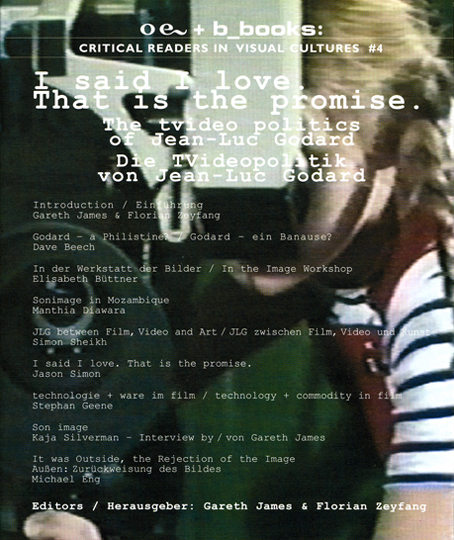
I said I love. That is the promise. The tvideo politics of Jean-Luc Godard focuses on this filmmaker's often neglected work in television and video. I said I love proposes that it is through this crucial encounter with video that Godard – together with Anne-Marie Miéville, his collaborator throughout this body of work – forced a number of re-articulations of the aesthetic, political and gendered understanding of images and sounds. What is here termed 'tvideo politics' obtains its political force from taking the images out of an economy of reproduction in order to recognize their place within an economy of production and distribution. These essays, talks and interviews analyze cinema, television and contemporary art through the politics of the visual and propose that Godard's turn to tvideo is an ongoing and extraordinary "provocation of what it means to see and to think."
Edited by Gareth James and Florian Zeyfang.
Texts by Dave Beech, Elisabeth Büttner, Manthia Diawara, Simon Sheikh, Jason Simon, Stephan Geene, Kaja Silverman and Michael Eng.
Order this book here.
____
#3: Rent
Edited by Stuart Koop.
English only.
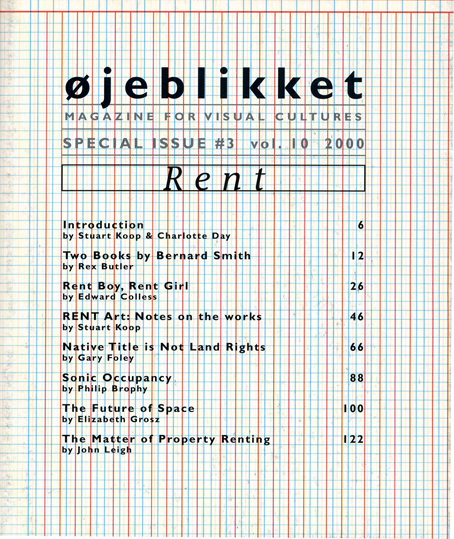
'Rent' describes the temporary relation many people have to the things around them. We do not own them and we do not create or produce them from scratch, though we do use and adapt them, for which we pay to borrow them. It applies to contemporary art too, putting another spin on appropriative tendencies in the wake of reception aesthetics (the reader, the bricoleur, the sampler, the renter); the adoption of certain themes, discourses or narratives which are adapted occasionally by artists for specific purposes. The term also suffuses cultural practice with a sense of proprietorial rights. The idea of artistic ownership and artistic origins is less pronounced today following its critique over the past 20 years, and perhaps especially in Australia where ownership is a vexed issue. Renting is a dominant paradigm describing not only a dilemma (in relation to an extant desire for ownership or creation), but a strategy for relevant, engaged art practice.
Edited by Stuart Koop. Texts by Rex Butler, Edward Colless, Stuart Koop, Gary Foley, Philip Brophy, Elizabeth Grosz and John Leigh.
Order this book here.
____
#2: Death Drive: Art and Film Beyond the Pleasure Principle
Edited by Gertrud Sandqvist.
English only.

Sigmund Freud's proposition that a death drive – as powerful as sexuality or the libido – is an integral part of the human psyche, created a lot of controversy when he first presented it in "Beyond the Pleasure Principle", 1920. Most psycho-analysts had major difficulties accepting that the destructive impulses were not tied to the libido; a sexuality having life and survival as its only goal. Freud claims that our psychologic constitution is dualistic; that one force craves for life and evermore complex organisms, and that another seeks death and simplicity. He furthermore connects the death instincts to sublimation, perhaps pointing to why the traces of the death drive seem so obvious in works of art. In his works, Freud himself points out culture, and more specifically art, as one of the death drive's most prominent arenas. This volume explores that arena.
Edited by Gertrud Sandqvist. Texts by Gertrud Sandqvist, Laura Mulvey, Friedrich Meschede, Matts Leiderstam/ Peggy Phelan and Denise Robinson.
Order this book here.
____
OUT OF PRINT:
#1: The Meaning of Site
Edited by Katya Sander, Simon Sheikh and Cecilie Høgsbro Østergaard.
English only.
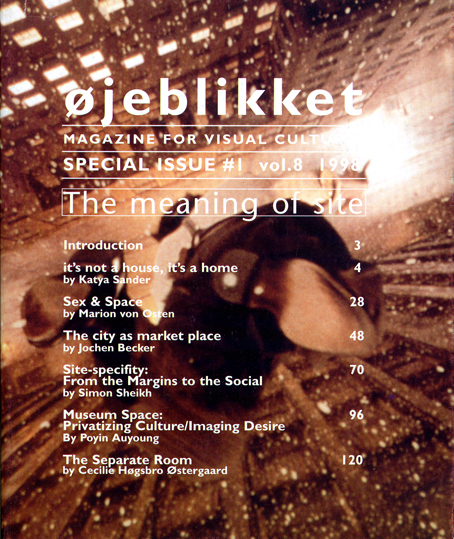
No space seems without meaning or content, but rather to be characterized by its activities, that is as different kinds of space, as different marked and marking sites. In other words, one can argue that we understand and analyze space through a method of site-specificity, that is on the one hand located to a specific geographical, social and architectural site, and on the other through the specific workings and identities of this given site. And it is the relations between these different and differentiated sites that makes up our notion of space – the meaning of site.
Edited by Katya Sander, Simon Sheikh and Cecilie Høgsbro Østergaard.
Texts by Katya Sander, Marion von Osten, Jochen Becker, Simon Sheikh, Poyin Auyoung and Cecilie Høgsbro Østergaard.
____
All titles available through 
|
|
|







